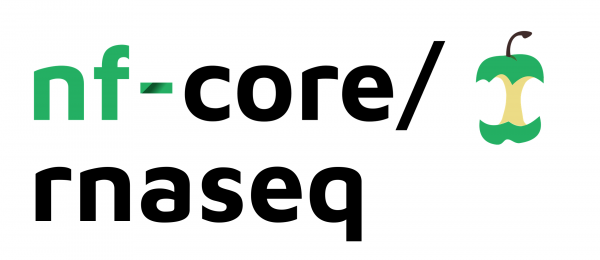nf-core/rnaseq is a bioinformatics pipeline that can be used to analyse RNA sequencing data obtained from organisms with a reference genome and annotation.
On release, automated continuous integration tests run the pipeline on a full-sized dataset obtained from the ENCODE Project Consortium on the AWS cloud infrastructure. This ensures that the pipeline runs on AWS, has sensible resource allocation defaults set to run on real-world datasets, and permits the persistent storage of results to benchmark between pipeline releases and other analysis sources. The results obtained from running the full-sized tests individually for each --aligner option can be viewed on the nf-core website e.g. the results for running the pipeline with --aligner star_salmon will be in a folder called aligner_star_salmon and so on.
The pipeline is built using Nextflow, a workflow tool to run tasks across multiple compute infrastructures in a very portable manner. It uses Docker/Singularity containers making installation trivial and results highly reproducible. The Nextflow DSL2 implementation of this pipeline uses one container per process which makes it much easier to maintain and update software dependencies. Where possible, these processes have been submitted to and installed from nf-core/modules in order to make them available to all nf-core pipelines, and to everyone within the Nextflow community!
- Download FastQ files via SRA, ENA or GEO ids and auto-create input samplesheet (
ENA FTP; if required) - Merge re-sequenced FastQ files (
cat) - Read QC (
FastQC) - UMI extraction (
UMI-tools) - Adapter and quality trimming (
Trim Galore!) - Removal of ribosomal RNA (
SortMeRNA) - Choice of multiple alignment and quantification routes:
- Sort and index alignments (
SAMtools) - UMI-based deduplication (
UMI-tools) - Duplicate read marking (
picard MarkDuplicates) - Transcript assembly and quantification (
StringTie) - Create bigWig coverage files (
BEDTools,bedGraphToBigWig) - Extensive quality control:
- Pseudo-alignment and quantification (
Salmon; optional) - Present QC for raw read, alignment, gene biotype, sample similarity, and strand-specificity checks (
MultiQC,R)
NB: Quantification isn't performed if using
--aligner hisat2due to the lack of an appropriate option to calculate accurate expression estimates from HISAT2 derived genomic alignments. However, you can use this route if you have a preference for the alignment, QC and other types of downstream analysis compatible with the output of HISAT2. NB: The--aligner star_rsemoption will require STAR indices built from version 2.7.6a or later. However, in order to support legacy usage of genomes hosted on AWS iGenomes the--aligner star_salmonoption requires indices built with STAR 2.6.1d or earlier. Please refer to this issue for further details.
-
Install
Nextflow(>=21.04.0). -
Install any of
Docker,Singularity,Podman,ShifterorCharliecloudfor full pipeline reproducibility (please only useCondaas a last resort; see docs). Note: This pipeline does not currently support running with Conda on macOS if the--remove_ribo_rnaparameter is used because the latest version of the SortMeRNA package is not available for this platform. -
Download the pipeline and test it on a minimal dataset with a single command:
nextflow run nf-core/rnaseq -profile test,<docker/singularity/podman/shifter/charliecloud/conda/institute>
- Please check nf-core/configs to see if a custom config file to run nf-core pipelines already exists for your Institute. If so, you can simply use
-profile <institute>in your command. This will enable eitherdockerorsingularityand set the appropriate execution settings for your local compute environment. - If you are using
singularitythen the pipeline will auto-detect this and attempt to download the Singularity images directly as opposed to performing a conversion from Docker images. If you are persistently observing issues downloading Singularity images directly due to timeout or network issues then please use the--singularity_pull_docker_containerparameter to pull and convert the Docker image instead. Alternatively, it is highly recommended to use thenf-core downloadcommand to pre-download all of the required containers before running the pipeline and to set theNXF_SINGULARITY_CACHEDIRorsingularity.cacheDirNextflow options to be able to store and re-use the images from a central location for future pipeline runs. - If you are using
conda, it is highly recommended to use theNXF_CONDA_CACHEDIRorconda.cacheDirsettings to store the environments in a central location for future pipeline runs.
- Please check nf-core/configs to see if a custom config file to run nf-core pipelines already exists for your Institute. If so, you can simply use
-
Start running your own analysis!
-
Typical command for RNA-seq analysis:
nextflow run nf-core/rnaseq \ --input samplesheet.csv \ --genome GRCh37 \ -profile <docker/singularity/podman/conda/institute> -
Typical command for downloading public data:
nextflow run nf-core/rnaseq \ --public_data_ids ids.txt \ -profile <docker/singularity/podman/conda/institute>
NB: The commands to obtain public data and to run the main arm of the pipeline are completely independent. This is intentional because it allows you to download all of the raw data in an initial pipeline run (
results/public_data/) and then to curate the auto-created samplesheet based on the available sample metadata before you run the pipeline again properly. -
See usage and parameter docs for all of the available options when running the pipeline.
The nf-core/rnaseq pipeline comes with documentation about the pipeline: usage and output.
These scripts were originally written for use at the National Genomics Infrastructure, part of SciLifeLab in Stockholm, Sweden, by Phil Ewels (@ewels) and Rickard Hammarén (@Hammarn).
The pipeline was re-written in Nextflow DSL2 by Harshil Patel (@drpatelh) from The Bioinformatics & Biostatistics Group at The Francis Crick Institute, London.
Many thanks to other who have helped out along the way too, including (but not limited to): @Galithil, @pditommaso, @orzechoj, @apeltzer, @colindaven, @lpantano, @olgabot, @jburos.
If you would like to contribute to this pipeline, please see the contributing guidelines.
For further information or help, don't hesitate to get in touch on the Slack #rnaseq channel (you can join with this invite).
If you use nf-core/rnaseq for your analysis, please cite it using the following doi: 10.5281/zenodo.1400710
An extensive list of references for the tools used by the pipeline can be found in the CITATIONS.md file.
You can cite the nf-core publication as follows:
The nf-core framework for community-curated bioinformatics pipelines.
Philip Ewels, Alexander Peltzer, Sven Fillinger, Harshil Patel, Johannes Alneberg, Andreas Wilm, Maxime Ulysse Garcia, Paolo Di Tommaso & Sven Nahnsen.
Nat Biotechnol. 2020 Feb 13. doi: 10.1038/s41587-020-0439-x.









